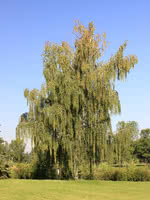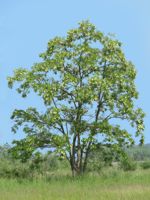Mon-Fri 9am - 5pm Mountain time
Cutleaf Weeping Birch vs Black Locust
Betula pendula laciniata
Robinia pseudoacacia
Cutleaf Weeping Birch is a tall, deciduous cultivar known for its pronounced weeping branches and ferny green leaves.
It features showy, peeling white bark and brilliant yellow leaves in the fall. Cutleaf Weeping Birch makes an exceptional accent tree for suburban yards.
If you are attracted to this tree, also look at the European White Birch which is similar.
Black Locust is an attractive tree. Its distinctive leaves are made of about a dozen bright green leaflets. It also notable for its fragrant white flowers, which smell of citrus.
Black Locust can grow in many situations, but prefers dry areas with lots of sun. It is robust and is an excellent choice for establishing shade in dry, open areas.
Important note: Much of the Black Locust is toxic to humans and livestock, including seeds, bark, and leaves.

